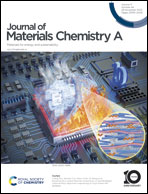Hydrogen bond-dominated polybenzimidazole semi-interpenetrating network membranes for alkaline water electrolysis†
Abstract
Polybenzimidazole (PBI) membranes are considered promising for the energy field, but are restricted by their unsatisfactory ionic conductivity. Thermoplastic phenolic resins (TPPRs) bearing abundant hydroxyl polar groups can contribute to the ionic transport of the PBI membranes. Herein, the interaction of PBI with TPPR introduced abundant hydrogen bonds, forming a hydrogen-bond dominated PBI/TPPR membrane with multiple ion channels to facilitate OH– transport. Moreover, C-PBI/TPPR semi-interpenetrating network (C-PBI/TPPR-sIPNs) membranes with multi-anchored sites were obtained by further cross-linking, which improved the stability. Molecular dynamics (MD) and density functional theory (DFT) simulations further confirmed that the hydrogen bonds between PBI and TPPR resulted in the formation of multiple ion transport channels in the membrane, strengthening the vehicle and Grotthuss transport mechanisms. As a result, the hydroxide ion conductivity of the novel membrane increased by approximately 2 times, and the membrane exhibited good durability. More importantly, these novel membranes were successfully applied in alkaline water electrolysis. This study will inspire further investigations on the binding mode and ion transport mechanism of PBI with other hydroxyl-containing species.



 Please wait while we load your content...
Please wait while we load your content...